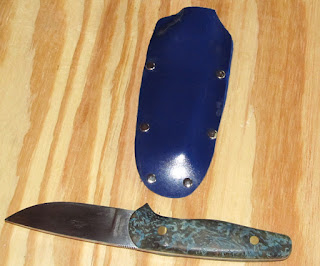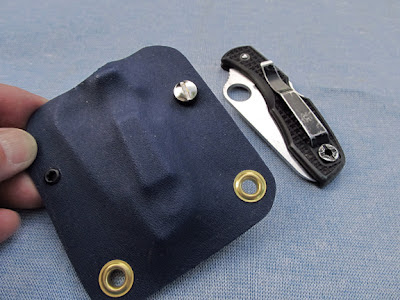In spite of the stinkin’ hot weather, I’ve been working playing with Kydex. I’m using the knife a friend gave me. I really like this knife, but it might not be the best to learn about Kydex sheath skills.
The sheath I have in mind is asymmetric. That is, the back is largely flat while the front takes the brunt of bulging and forms the blade and knife handle pocket. I want the back as flat as possible to make attaching a belt clip easy and flat against the sheath so the knife is held in tight to the body. This handle calls for a lot of Kydex flow.
I also want the sheath to be trim and smartly shaped. I can already make sheaths that looks like two pieces of plywood nailed together. I want an organic (I hate that word, but I’m actually working with organic materials, so….) look that suggests the sheath grew around the knife.
I have quite a ways to go.
To facilitate reaching these goals I’ve bought two new tools. The first is a small set of French curves. I used to use them to help draw graphs in math and science. For those of you who only know Excel or any of the other graphing software there was a time….
A time when a man would place a razor to his throat and he would slip and cry out in pain and blood would well up …. Oops! Wrong time!!
What you really did was plot points as x and y coordinates. If you could connect them with a straight line great, but sometimes it wasn’t possible, so you got out a pack of French curves and found a section of the curves that matched your points and drew the line.
I’m using the curves to help me trace lines on the Kydex to give my sheath a fluidness and shape that is functional, minimalist and attractive.
Am I asking for TOO MUCH?
I don’t know, but there is an art, a creative side to sheath making. Sherlock used to say "Art in the blood is liable to take the strangest forms” (The Greek Interpreter). So true.
To help me trim the excess Kydex from the line I can now draw I bought a band saw. I also bought it to do a little woodworking, but I had Kydex in mind when I purchased it.
 |
| I went to Sears. It's a Craftsman. I wanted the 12 HP saw, but it was a little out of my league.... |
I was quite happy that my first band saw/Kydex sheath project was working out until for some reason, it took a jog sideways, hit a rivet and skittered away.
 |
| The second rivet down on the right shows were the band saw and I departed from the planned operation. |
 |
| Back side. This is the reason I want the back so flat. I need the sheath to hug the body. I've lost too many knives 'cause they canted out from my body and got snagged by a coat or sweater. |
Well, practice makes perfect. My big problem is spacing the rivets and leaving enough Kydex outboard of the rivet so I can cut, trim and polish. The curves don’t work so well on non-flat, irregularly shaped objects and I need a better way to draw on Kydex other than pencil.
I have been working on a Kydex neck sheath for a Delica Salt.
It’s big and I tried it out in the salty Gulf of Mexico and the H1 steel didn’t rust, and more importantly, the knife didn’t fall out. Now that I have a band saw, it’s time to revisit that project.

1 comment:
A bench grinder or drill press and a sanding drum can also work wonders to do edge work on the kydex after the band saw gets you close to final size.
Post a Comment